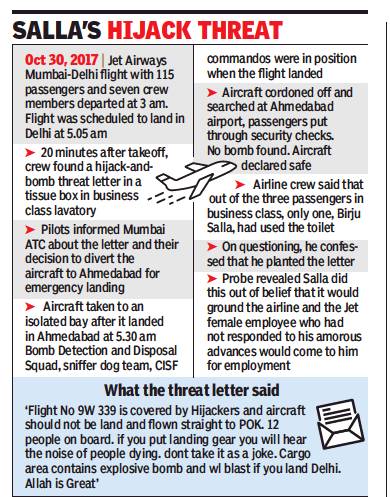Anti-Hijacking Act
This is a collection of articles archived for the excellence of their content. |
Hijack threat
Punishment
Bharti Jain, June 12, 2019: The Times of India

From: Bharti Jain, June 12, 2019: The Times of India
Life term or death only possible punishment
New Delhi:
The National Investigation Agency(NIA) court handing out a life sentence to Jet Airways hijack scare case convict Birju Kumar Salla, a Mumbai-based businessman, came as no surprise.
Under the Anti-Hijacking Act of 2016, any person who makes a threat to commit a hijack or intentionally causes a person to receive a seemingly credible hijack threat is deemed to have committed the offence. And such person, the Act unequivocally states, must be punished with death where the hijack act results in death of a victim; and life imprisonment for the remainder of the convict’s life where no fatality is involved.
Even the original Anti-Hijacking Act of 1982 laid down life imprisonment as the only punishment for an act of hijacking, which included an attempt to hijack. The definition of hijacking was widened under the antihijacking law passed in 2016, to include threat to commit such offence or causing a person to receive such threat under circumstances indicating the threat to be credible.
The offence of hijacking now also covers attempts to commit or abetting commitment of such offence; intentionally assisting a person to evade investigation, prosecution or punishment for such an offence; agreeing to commit the offence along with other persons, and knowingly contributing in any manner to commission of the hijack.
“Even though Salla did not actually commit the act of hijacking, that he intentionally planted a letter threatening that 12 hijackers, one of them being himself, were on board and that there were explosives in the cargo area, qualifies as a hijack threat and attempt. He was masquerading as a hijacker. The conviction and life sentence should serve as a major deterrent for those who indulge in such hijack scares for the heck of it,” an NIA official told TOI.
The Anti-Hijacking Act was made tougher in the light of experiences from the hijack of an Indian Airlines aircraft in 1999, soon after it flew out of Kathmandu with over 170 passengers. The hijack led to a hostage crisis, with the hijackers diverting the aircraft to Kandahar in Afghanistan. The then Vajpayee government was forced to secure release of the hostages by agreeing to swap them for three incarcerated terrorists, including Maulana Masood Azhar who now heads the Jaish-e-Muhammed.
What the 2016 rules say
Abhinav Garg, August 18, 2019: The Times of India

From: Abhinav Garg, August 18, 2019: The Times of India
The 2016 Anti-Hijacking Act replaces a 1982-vintage law, according to which hijackers could be tried only in the event of death of hostages, such as flight crew, passengers and security personnel.
“Under the new law, definition has been expanded to include death of security personnel on board or ground support staff as well. In case of no deaths, the accused will be punished with imprisonment for life and fine, besides confiscation of movable and immovable property held by him or her. The 2016 Act also includes several acts within the definition of hijacking, including making a threat, hoax, attempts or abetment to commit the offence,” says a Delhi-based prosecutor.
Those who organize or direct others to commit such offence will also be considered to have committed the offence of hijacking.